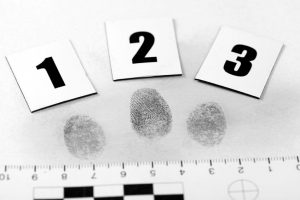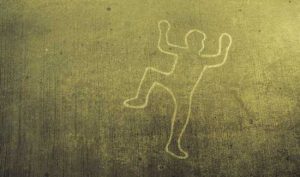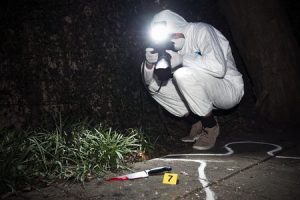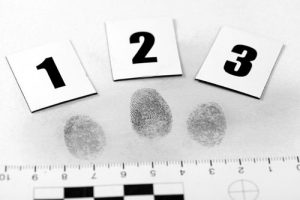From motoring offences to murder, people commit crimes every day.
Some of these are unintentional, with no premeditation or planning – they just happen, such as a car accident. Other people meticulously plan the crime they commit, right down to the last detail. They will take many steps to avoid detection.
When (or if) they are caught and charged, they may still continue to deny any wrongdoing.

There are many people involved in detecting and solving crimes. From police officers to forensic scientists, to the psychologists who work with offenders, there are many professionals involved in the process.
Some people who commit crimes are of sound mind, fully aware of the crime they have committed and its affects. Others are driven by poor mental health, unfettered anger, jealousy or hate.
A Complex and Rewarding Field of Study and Work
As you can see, detecting and solving crimes, working with victims and their families, and dealing with criminals is complex. Working in the field of crime detection is a rewarding career in many ways, but it also a field of work that can be harrowing.
This is valuable work, and that is why many people want to get involved in solving crimes, catching criminals and supporting victims and their families. They can be part of the prosecution process or they can be the forensic scientists that gather the evidence at the crime scene.
Do you have what it takes to be a crime solver?
How to solve a crime
In the UK, crimes are investigated by criminal agencies such as the police. There are some crimes that are investigated by specialist criminal agencies, such as financial fraud or online cybercrimes.
The people responsible for solving a crime may have a small, finite number of clues and evidence to work with. It takes knowledge, skill, determination and a heavy dose of courage to seek out the perpetrator.
So, how do you solve a crime?
#1 Document EVERYTHING
At first glance, some crime scenes can render very little information. Neighbours say they didn’t see anything. Relatives and friends say they now nothing.
But, as seasoned detectives will tell you, at every crime scene there are golden nuggets of information. From names to times, dates and ‘I did see…’ moments, the vital clues you need are all there.
Some are well hidden, and this is why the police and other investigating agencies rely on the systematic work of forensic scientists. Alongside officers, they gather minute, almost invisible information that could lead to the perpetrator.
There are other people that police turn to when trying to solve a crime. For example, a criminal psychologist can profile the person the police are possibly looking for, based on the type of crime committed and the evidence left behind.
#2 Create a Timeline
Nailing down the timing of the crime is essential, and that means creating a detailed timeline of what happened and when. This is done by gathering evidence from witnesses, as well as by reviewing CCTV and other forms of evidence.
#3 Follow Every Lead
There are many red herrings (dead ends) to any investigation into any crime, from murder to theft, and they all need to be looked at in detail.
The same is true of forensic evidence. Questions need to be asked of the evidence, and this is why people who investigate crimes follow a set method and structure. It is often true that a small piece of evidence can be the link to the perpetrator.
#4 Everything is Evidence

So, how do you solve a crime?
This means that every part of the crime scene is preserved. Every word everyone says to you as a detective is recorded. Every hair, bead of sweat or drop of blood left at the scene treated in a careful way to prevent contamination – in other words, it can tell its story, and that means it can help you get to the truth.
#5 Persevere
Not all crimes are solved neatly, fitting with the neat timescale we see on TV programmes. Real life cases can be cold for years, but with changes and advances in detection techniques, they can be solved decades later.
What Part Can You Play in Crime Detection?
There are many people involved in detecting and solving crimes. From police officers to forensic scientists, to the psychologists who work with offenders, there are many professionals involved in the process.
And you could be one of them! At NCC, we have many courses, such as a criminology courses and an online criminology diploma that is used by students as a stepping-stone into crime detection work.
It can be harrowing work but rewarding. Are you cut out for a career in the world of crime?
Sherlock Holmes was a fictional character created by Sir Arthur Conan Doyle. Originally created for a series of books and novels eventually, the great detective appeared on the small and big screen.
The recent resurrection of the character by Stephen Moffatt and Mark Gatiss, and played by Benedict Cumberbatch, has ignited our interest in how the private detective was seen to solve cases.
In fact, the idea was that Sherlock Holmes and his sidekick Dr Watson could solve crimes by using magic-like powers of deduction, backed by science. There has also been a hint in the modern BBC series that Holmes had high-functioning autism, verging on genius.
Criminology – What is it?
Others suggest that Conan Doyle used a process of deduction and elimination that we still use today.

Many people in modern-day crime detection roles have a broad understanding on criminology and then go on to specialise in certain key areas.
Criminology is the study of all aspects of crime and law enforcement. This includes criminal psychology, the social setting of a crime, prohibition and prevention as well as the investigation and detective methods. It also studies capture and punishment.
There are many people involved – lawmakers, social workers, probation officers, judges, detectives and so on.
Some of the detective means that Conan Doyle has Holmes use to solve crimes are still used today…
#1 Fingerprints
The Sign of Four published in 1890 was the first case in which Conan Doyle included the use of fingerprints in solving a crime. No big deal, you may think, as fingerprinting technology is widely used and understood today.
But what makes this stand out is that Scotland Yard didn’t start to use fingerprinting as part of crime detection until 1901, some 11 years after this story was published.
What makes this even more interesting in that Conan Doyle had Holmes use fingerprints and not a competing forensic theory call ‘bertillonage’. This forensic theory identified and measured the twelve characteristics of the body but Conan Doyle backed the winner, with fingerprinting becoming the preferred forensic method.
#2 Typed Documents
In the age of modern computing, you again may think that again, examining typed print is nothing new. But back when typewriters were common place, Holmes used the small discrepancies between one typewriter and another to detect the criminal.
A Case of Identity was published in 1891 with Holmes solving the crime by comparing the typewriter of the culprit with the letters the victim received. The Federal Bureau of Investigation didn’t start its Document Section analysing this kind of work until 1932, nearly 40 years after Conan Doyle used it.
#3 Handwriting

Criminology is the study of all aspects of crime and law enforcement. This includes criminal psychology, the social setting of a crime, prohibition and prevention as well as the investigation and detective methods. It also studies capture and punishment.
Conan Doyle somewhat exaggerates Holmes’ ability to deduce information from handwritten notes – he can determine gender, whether two note writers are related, determine character and so on.
Although Conan Doyle did over egg this particular subject in the nine stories that featured handwriting analysis, he wasn’t far off the mark.
Today, police and law enforcement agencies regularly review and analyse handwriting. There is also a growing school of thought relating the forensic linguistics and linguistic ‘fingerprinting’, which compares and contrasts the writing of the victim and notes, texts or emails that look to have been written by someone else.
Again, Conan Doyle was years ahead of his time.
#4 What the evidence is telling us
There are times when evidence is in plain sight. In Sherlock Holmes stories, there are frequent references to animals, more specifically dogs.
For example, the police inspector in one story claims that the ‘dog did nothing in the night’. Holmes refers to this as the ‘curious incident of the dog in the night time’, with his suspicions immediately falling on to a culprit.
In another story, a victim’s dog snarled ‘when it shouldn’t’, indicating to Holmes that the culprit was a stranger. In this story, a stranger was masquerading as its mistress and the dog registered distaste and fear by snarling.
In modern crimes, there are many pieces of evidence that act as clues and pointers to who or why a crime was committed. Dogs are used to detect crimes such as buried bodies, counterfeit money, drugs and more.
Studying Criminology
There is no doubt that crime, its detection and prevention is a fast-paced career, enjoyed by many in various roles and guises.
Solving a crime, understanding why it happened and its triggers that give rise to possible prevention methods are studied throughout various Criminology courses online.
Many people in modern-day crime detection roles have a broad understanding on criminology and then go on to specialise in certain key areas.
It is a demanding but rewarding role, with the criminologist being an important cog in the wheel of justice and has been for decades. Is it the right career for you?
This could be one of the reasons why you are searching from criminology courses online. You may also be interested in a career within a related field and having a criminology qualification will be valuable.
What is criminology?
Criminology is the study of crime from a social perspective. For example, what the causes of crime are, the social impact of it and how or why people choose to be involved in crime. People who study criminology hope to better understand what motivates criminals to act in the way that they do.
The work focuses on studying:

Criminology is an interesting area of study and one that can be insightful in so many ways.
- Theories that explain illegal and/or deviant behaviour
- The social reaction to crime – such as why we find some crime more abhorrent than others
- The political landscape of social control
- The effectiveness of anti-crime policies and measures
- Criminals and their crimes
- The crime itself
- And, incredibly important is the impact of crime on the victims
Criminology qualifications are welcomed across a wide sphere of careers and roles such as community development worker, police officer, prison officers, probation work, social work and youth workers.
There are also many other career paths open to you with criminology qualifications too.
Why study criminology courses online?
It is a wide area of study and one that draws students from all walks of life. Criminology is often associated with being an academic subject and in many ways, this is true.
You will look at and study theories, some controversial and others widely accepted, and you will be required to comment on them, or apply them in a practical situation. There can be a lot of reading associated with this kind of study but there is no doubt that if you have a passion for understanding what makes people tick, then this is the area of study for you.
For many people, they feel their career progression or a change of career is hampered by many obstacles and hurdles. They understand that they need to study and gain more qualifications but feel that they cannot take the financial risk of either cutting their work hours or giving up their job completely, to attend college or university.
- Course content and value – we understand that every course we offer needs to have value to it for both you, the student and your employers. This is why we work with leading qualification accreditation bodies so that you can be confident when you sign up to one of our courses, you are signing up to the best.
- Expert tutors – written, developed and tutored by expert tutors, all our courses are enhanced by the tutor team. Not only are our tutors highly qualified, they are also highly experienced with many years of teaching experience, as well as practical skills and experience within their field.
- Generous support packages – for any student, whether you are studying online or in a classroom, support is an integral part of the learning process. Support means different things to different students; for example, you may need guidance and help with writing assignments, but for others it could be time management or how to plan an essay. We have the right support in place, just waiting for you to tap into when you want and need it.

There is another option – self-directed study with online courses. There are many benefits of studying criminology courses online and to do so with NCC Home Learning
- Vibrant online community – learning shouldn’t be a lonely or isolated experience which is why we encourage people to make contact with fellow students, both here at NCC Home Learning and on specialist, topic-led forums you find across the web.
- Self-pacing and managing – studying online means you can complete your course at your own pace. We always advise students to spend as much time as they need on modules so that they have a deep understanding of the topics being discussed. Essentially, however, you set your own learning pace. There are no chasing emails, no lurking deadlines and no pressure, just all-round great support from an expert team.
How to enrol
Enrolling with NCC Home Learning is easy, simple and quick:
- Select a course from our forensic science courses
- Choose the form you prefer – online or paper (not all our courses are available online, so check carefully)
- Choose how to pay – you can pay in one lump sum or choose to pay by instalments
- You are now enrolled and part of an exciting online learning community and looking forward to new challenges!
